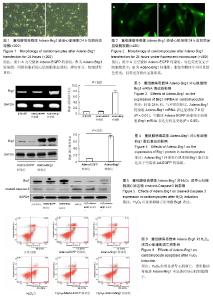[1] Xu Y,Wang L,He J,et al.Prevalence and control of diabetes in Chinese adults.Jama. 2013;310:948-959.
[2] Krum H,Gilbert RE.Demographics and concomitant disorders in heart failure.Lancet. 2003;362:147-158.
[3] Ho L,Crabtree GR.Chromatin remodelling during development.Nature.2010;463:474-484.
[4] Hang CT,Yang J,Han P,et al.Chromatin regulation by Brg1 underlies heart muscle development and disease. Nature.2010;466:62-67.
[5] Takeuchi JK,Lou X,Alexander JM,et al.Chromatin remodelling complex dosage modulates transcription factor function in heart development.Nature communications.2011;2:187.
[6] Stankunas K,Hang CT,Tsun ZY,et al.Endocardial Brg1 represses ADAMTS1 to maintain the microenvironment for myocardial morphogenesis.Dev Cell.2008;14:298-311.
[7] Xu J,Lei S,Liu Y,et al.Antioxidant N-acetylcysteine attenuates the reduction of Brg1 protein expression in the myocardium of type 1 diabetic rats.J Diabetes Res. 2013;2013:716219.
[8] The Ministry of Science and Technology of the People’s Republic of China. Guidance Suggestions for the Care and Use of Laboratory Animals.2009.
[9] Simpson P,Savion S.Differentiation of rat myocytes in single cell cultures with and without proliferating nonmyocardial cells.Cross-striations, ultrastructure, and chronotropic response to isoproterenol.Circ Res.1982;50:101-116.
[10] Opie LH.Acute myocardial infarction and diabetes. Lancet.2007;370:634-635.
[11] Norhammar A,Schenck-Gustafsson K.Type 2 diabetes and cardiovascular disease in women. Diabetologia. 2013;56:1-9.
[12] Falcao-Pires I,Leite-Moreira AF.Diabetic cardiomyopathy: understanding the molecular and cellular basis to progress in diagnosis and treatment.Heart Fail Rev. 2012;17:325-344.
[13] Rajesh M,Mukhopadhyay P,Batkai S,et al.Cannabidiol attenuates cardiac dysfunction, oxidative stress, fibrosis, and inflammatory and cell death signaling pathways in diabetic cardiomyopathy.J Am Coll Cardiol.2010;56:2115-2125.
[14] Wold LE,Ceylan-Isik AF,Ren J.Oxidative stress and stress signaling: menace of diabetic cardiomyopathy. Acta PharmacolSin.2005;26:908-917.
[15] Selvaraju V,Joshi M,Suresh S,et al.Diabetes, oxidative stress, molecular mechanism, and cardiovascular disease--an overview.Toxicol Mech Methods. 2012;22: 330-335.
[16] Mohrmann L,Verrijzer CP.Composition and functional specificity of SWI2/SNF2 class chromatin remodeling complexes.Biochim Biophys Acta.2005;1681:59-73.
[17] Trotter KW and Archer TK. The BRG1 transcriptional coregulator. Nucl Recept Signal. 2008;6:e004.
[18] Sumi-Ichinose C,Ichinose H,Metzger D,et al. SNF2beta-BRG1 is essential for the viability of F9 murine embryonal carcinoma cells.Mol Cell Biol. 1997; 17:5976-5986.
[19] Weiss RM,Guo S,Shan A,et al.Brg1 determines urothelial cell fate during ureter development.J Am Soc Nephrol.2013;24(4):618-626.
[20] Xiong Y,Li W,Shang C,et al.Brg1 governs a positive feedback circuit in the hair follicle for tissue regeneration and repair.Dev Cell.2013;25:169-181.
[21] Reyes JC,Barra J,Muchardt C,et al.Altered control of cellular proliferation in the absence of mammalian brahma (SNF2alpha).EMBO J.1998;17:6979-6991.
[22] Willis MS,Homeister JW,Rosson GB,et al.Functional redundancy of SWI/SNF catalytic subunits in maintaining vascular endothelial cells in the adult heart.Circ Res.2012;111:e111-122.
[23] Bultman S,Gebuhr T,Yee D,et al.A Brg1 null mutation in the mouse reveals functional differences among mammalian SWI/SNF complexes.Molecular cell.2000; 6: 1287-1295.
[24] Bourgo RJ,Siddiqui H,Fox S,et al.SWI/SNF deficiency results in aberrant chromatin organization, mitotic failure, and diminished proliferative capacity.Mol Biol Cell. 2009;20:3192-3199.

